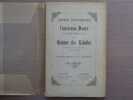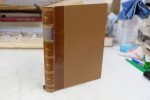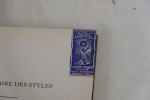-
Type
Any type (2)
Art print (7)
Book (31052)
Disk (1)
Drawings (7)
Engraving (9)
Magazine (130)
Old papers (1)
Photographs (14)
Posters (4)
-
Latest
Last 24h (2)
Last 3 days (18)
Last month (294)
Last week (42)
-
Language
Dutch (1)
English (54)
French (31126)
German (6)
Italian (18)
Japanese (2)
Portuguese (9)
Spanish (11)
-
Century
16th (16)
17th (56)
18th (210)
19th (1564)
20th (9371)
21st (1697)
-
Countries
Belgium (9472)
Brazil (7)
Canada (108)
China (3)
Côte d'Ivoire (63)
Denmark (215)
France (18270)
Germany (1)
Greece (1)
Italy (36)
Switzerland (3051)
-
Syndicate
ALAC (99)
CLAM (42)
CLAQ (94)
CNE (3)
ILAB (10813)
NVVA (1161)
SLACES (1161)
SLAM (8287)
SNCAO (9)
LE NORD. UN ART DE VIVRE ENTRE BEFFROIS ET MOULINS
La Renaissance du Livre 2001 In-4 à l’italienne, relié sous jaquette illustrée en couleurs.
Très bon état d’occasion
"Antonio Gaudi 1852-1926 (Collection ""Art et artistes, série Les Architectes"")"
A. Hatier. 1955. In-12. Broché. A relier, Couv. légèrement passée, Coiffe en tête abîmée, Papier jauni. Environ 70 pages. Nombreuses planches d'illustrations, photos en noir et blanc et en couleurs. Quelques pages désolidarisées. Couverture contrepliée, partiellement désolidarisée. Accrocs en coiffe en tête. Quelques rousseurs.. . . . Classification Dewey : 720-Architecture
"Collection ""Art et artistes, série Les Architectes"". Classification Dewey : 720-Architecture"
Palais du Rajasthan
L'architecture palatiale de l'État du Rajasthan, au nord-ouest de l'Inde, est très certainement la plus exceptionnelle de l'architecture civile indienne ; c'est sans doute la raison pour laquelle il s'agit de la région la plus visitée - et la plus aimée - des touristes français. - Format : Broché, 270 pages - Dimensions : 26,0 x 33,5 x 2,8 cm - Illustrations en couleurs - Etat très correct, légers griffements très peu discernables
Oblique n° 2, réplique.
Renens, Vie Art Cité Association 2012, 280x230mm, reliure demi-toile de l’éditeur. Tiré à 1500 exemplaire. Exemplaire à l'état de neuf.
photos couleurs et n/b, Pour un paiement via PayPal, veuillez nous en faire la demande et nous vous enverrons une facture PayPal
Mont Loon : Reflet fidèle de la montagne et des environs de Laon, de 1100 à 1300
Editions de l’Imprimerie du Courrier de l’Aisne 1972 In-4 relié 30 cm sur 21,5. 169 pages. Bon état d’occasion.
Bon état d’occasion
Notice historique sur l'ancienne Route de Charles-Emmanuel II et les Grottes des Echelles. Avec pièces justificatives et documents.
Librairie A. Perrin - Librairie A. Bolliet Chambéry - Aix-Les-Bains 1887 In-8 ( 225 X 140 mm ) de XVI-235 pages, broché sous couverture imprimée. EDITION ORIGINALE. Rousseurs passim, bon exemplaire, non coupé.Extrait de la table: Etat des communications entre la vallée des Echelles et celles de Couz, à l'époque romaine. - Construction de la route de Charles-Emmanuel II, 1re période: études préliminaires le maître auditeur Deschamps. - Construction de la route de Charles-Emmanuel II. 2e période: projets et travaux d?exécution le maître auditeur Balland. - Le monument élevé à Charles-Emmanuel II à la route des Echelles. Déboires de Balland au sujet de l'inscription commémorative qui y figure Etc, Etc.
A History of Pictures : From the Cave to the Computer Screen David Hockney & Martin Gayford -
, Abrams, 2020 Paperback, 370 pages, ENG. edition, 240 x 165 mm, NEW, richly illustrated in color / b/w. ISBN 9781419750281.
A compact edition of Hockney and Gayford?s brilliantly original book, with updated material and brand-new pieces of art Informed and energized by a lifetime of painting, drawing, and making images with cameras, David Hockney, in collaboration with art critic Martin Gayford, explores how and why pictures have been made across the millennia. Juxtaposing a rich variety of images?a still from a Disney cartoon with a Japanese woodblock print by Hiroshige, a scene from an Eisenstein film with a Velazquez paint ing?the authors cross the normal boundaries between high culture and popular entertainment, and argue that film, photography, paint ing, and drawing are deeply interconnected. Featuring a revised final chapter with some of Hockney?s latest works, this new, compact edition of A History of Pictures remains a significant contribution to the discussion of how artists represent reality. David Hockney is one of the world?s most popular painters and the author of the bestselling Secret Knowledge: Rediscovering the Lost Techniques of the Old Masters (2001). Martin Gayford is an art critic and the author of many books, including Man with a Blue Scarf: On Sitting for a Portrait by Lucian Freud (2013) and Rendez-vous with Art, with Philippe de Montebello (2014).
Rome And Jerusalem : The Clash Of Ancient Civilizations
, Penguin Books Ltd 2007, 2007 Hardcover, 656 pages, English, 240 x 165 mm, with some illustrations in b/w, in good order, . ISBN 9780713994476.
In this magisterial history of the titanic struggle between the Roman and Jewish worlds that led to the destruction of Jerusalem, Goodman examines this conflict, its causes, and its consequences with unprecedented authority and thoroughness.
Francis Bacon Retrieved Lost Words / New Writing
London, Thames & Hudson, 2025 Softcover, 232 pages, 26 x 20 cm, english text. *New . ISBN 9780500966273.
The fifth volume in the acclaimed Francis Bacon Studies series, published under the aegis of The Estate of Francis Bacon. David Sylvester's Interviews with Francis Bacon remain the most consulted writing on Bacon. In this book, the fifth volume in the acclaimed Francis Bacon Studies series, Bacon's words appear in their unredacted form for the very first time. Other essays throw light on form and accident in Bacon's work, chimera and liminal entities, the psychology of the imposter and destroyed
Francis Bacon Retrieved Lost Words / New Writing
, Thames & Hudson, 2025 Hardback, 260 x 200 mm, 100 Illustrations col.ill., 232 Pages, English ed. *new. ISBN 9780500966273.
Martin Harrison, Maria Balaska, Amanda J. Harrison, Darian Leader The fifth volume in the acclaimed Francis Bacon Studies series, published under the aegis of The Estate of Francis Bacon. David Sylvester's Interviews with Francis Bacon remain the most consulted writing on Bacon. In this book, Bacon's words appear in their unredacted form for the very first time. Other essays throw light on form and accident in Bacon's work, chimera and liminal entities, the psychology of the imposter and destroyed paintings
Complete Content Cameos.
, Brepols 2018, 2018 Hardcover.iv + 407 p., 583 col. ills, 225 x 300 mm, English, , . ISBN 9782503578965.
This catalogue of the largest collection of ancient cameos in private hands, represents forty years of collecting these historical documents in hardstone. While part of the collection was on public display at the Ashmolean Museum, Oxford (1990-2000), the whole collection has never been shown. Several recent publications have made it possible to draw more precise conclusions based on a larger sample of cameos available for comparative study. This increased number of published cameos has allowed studies of the popularity of particular subjects at certain periods, of the development of styles and techniques, and of the relative popularity of some gem materials over time. The development of digital photography has enabled gem photographers to show undreamt-of detail, allowing much closer study of tool marks and even individual artists' hands.
LA GRAMMAIRE DES STYLES. COLLECTION DE PRÉCIS SUR L'HISTOIRE DE L'ART. LE STYLE LOUIS XIII. LE STYLE LOUIS XIV. LE STYLE LOUIS XV. LE STYLE XVI. LE STYLE EMPIRE.
1929 chez Flammarion. In-8, relié, 60 pages. Nombreuses illustrations en noir et blanc. Exemplaire en bon état. Présence de quelques marques d’usage. Vignette ex-libris.
LA GRAMMAIRE DES STYLES. LA RENAISSANCE FRANCAISE.
Librairie d'Art R. Ducher. 1928. In-8. Broché. Etat d'usage, Plats abîmés, Dos abîmé, Intérieur bon état. 63 pages, 42 figures dans le texte, 12 planches hors texte avec 37 documents, tampon, manque couverture.. . . . Classification Dewey : 720-Architecture
Collection de précis sur l'histoire de l'art publiée sous la direction de Herny Martin. Classification Dewey : 720-Architecture
La grammaire des styles. La Renaissance italienne.
broché - 15,5x22 - 63 pp - 1946 - éditions FLAMMARION, Paris. Ouvrage orné de 47 figures dans le texte et de 15 planches hors texte.Collection de précis sur l'histoire de l'art, publiée sous la direction de Henry MARTIN.42ème mille.
La grammaire des styles. La Renaissance italienne.
broché - 15,5x22 - 63 pp - 1948 - éditions FLAMMARION, Paris. Ouvrage orné de 47 figures dans le texte et de 15 planches hors texte.Collection de précis sur l'histoire de l'art, publiée sous la direction de Henry MARTIN.32ème mille.
La grammaire des styles : L'art byzantin.
Couverture souple. Broché. 64 pages.
Livre. Editions Flammarion, 1946.
LA GRAMMAIRE DES STYLES. L'ART GOTHIQUE.
Librairie d'art R. Ducher. 1930. In-8. Broché. Etat d'usage, Couv. défraîchie, Dos frotté, Intérieur bon état. 63 pages, 21 illustrations noir et blanc dans le texte, 22 planches hors texte, tampon.. . . . Classification Dewey : 720-Architecture
Collection de précis sur l'histoire de l'art publiée sous la direction de Henry Martin. Classification Dewey : 720-Architecture
La grammaire des styles. L'art roman
Flammarion Flammarion, 1984. In-8 broché, 63 pages + 31 figures. Bon état.
Toutes les expéditions sont faites en suivi au-dessus de 25 euros. Expédition quotidienne pour les envois simples, suivis, recommandés ou Colissimo.
LA GRAMMAIRE DES STYLES - LE STYLE LOUIS XVI -
LIBRAIRIE D'ART R. DUCHER. 1929. In-8. Broché. Etat d'usage, Couv. défraîchie, Dos très frotté, Intérieur frais. 65 pages dont 50 gravures en noir et blanc hors texte. Salissures sur la 1ère page.. . . . Classification Dewey : 720-Architecture
2ème édition Classification Dewey : 720-Architecture
La renaissance italienne
Flammarion 1958 in8. 1958. Broché.
bords légèrement frotté intérieur propre bonne tenue
"L'art gothique (Collection : ""La Grammaire des Styles"")"
Flammarion. 1954. In-8. Broché. Bon état, Couv. convenable, Dos satisfaisant, Intérieur frais. 63 pages augmentées de 78 photos et illustrations en noir et blanc dans et hors texte. Frontispice en noir et blanc.. . . . Classification Dewey : 720-Architecture
"Collection : ""La Grammaire des Styles"". Classification Dewey : 720-Architecture"
L'art musulman.
Paris, Flammarion, collection "La grammaire des styles", 1947, 1 br., mouillure sur le plat sup. in-8 de 64 pp., orné de 29 figures dans le texte et de 14 planches h.t., mouillure sur la première page ;
Phone number : 06 80 15 77 01
L'art roman, 96 illustrations - Collection La Grammaire des Styles.
Flammarion. 1946. In-8. Broché. Etat d'usage, Couv. convenable, Coiffe en pied abîmée, Intérieur frais. 63 pages, nombreuses photos, figures et illustrations en noir et blanc dans et hors texte - annotation à l'encre sur la page de titre.. . . . Classification Dewey : 720-Architecture
Collection La Grammaire des Styles. Classification Dewey : 720-Architecture
"L'Art Roman (Collection : ""La Grammaire des Styles"")"
Flammarion. 1954. In-8. Broché. Etat d'usage, Couv. convenable, Dos satisfaisant, Intérieur frais. 63 pages augmentées de 96 photos et illustrations en noir et blanc dans et hors texte. Frontispice en noir et blanc. Une signature au crayon sur la page de faux titre et le premier plat.. . . . Classification Dewey : 720-Architecture
"Collection : ""La Grammaire des Styles"". Classification Dewey : 720-Architecture"
"L'art Gothique (Collection : ""La Grammaire des Styles"")"
Flammarion. 1980. In-8. Broché. Bon état, Couv. convenable, Dos satisfaisant, Intérieur frais. 63 pages augmentées de nombreuses photos et illustrations en noir et blanc dans et hors texte. Frontispice en noir et blanc.. . . . Classification Dewey : 720-Architecture
"Collection : ""La Grammaire des Styles"". Classification Dewey : 720-Architecture"
 Write to the booksellers
Write to the booksellers



















